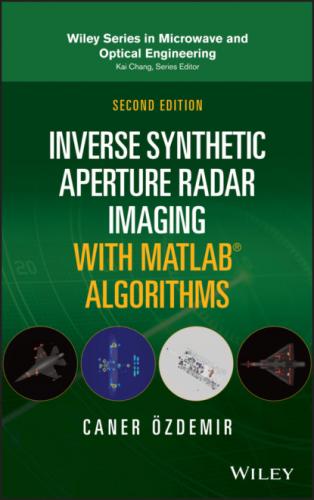In radar applications, LFM pulse waveforms are mainly utilized in finding range profiles, and also for synthetic aperture radar (SAR) and ISAR processing as will be discussed in Chapters 3 and 6, respectively.
Figure 2.20 Comparison of the spectrum of (a) single‐tone pulse and (b) LFM pulse. Although both signals use the same time duration, frequency bandwidth of the Chirp waveform is much wider than the single‐tone waveform.
2.7 Pulsed Radar
Pulsed radar systems are commonly used especially in SAR and ISAR systems. They transmit and receive a sequence of modulated pulses. Therefore, the same type of pulse is repeated in every TPR interval, or, as it is called, PRI as depicted in Figure 2.21. The range information can be gathered from the two‐way trip time (or time delay) between the transmitted and received pulses. Pulsed radar systems have the ability to measure both the range (the radial distance) and the radial velocity of the target.
2.7.1 Pulse Repetition Frequency
As pulses are repeated in TPR, the corresponding PRF of the radar is as given in Eq. 2.60. PRF gives the total number of pulses transmitted in every second by the radar. In radar applications, PRF value can be quite critical as it is linked to maximum range of a target, Rmax, and the maximum Doppler frequency, fD,max (so the maximum target velocity vmax of the target), that can be detectable by the radar. The use of PRF in ISAR range‐Doppler processing will be explored in Chapter 6.
2.7.2 Maximum Range and Range Ambiguity
As calculated in Eq. 2.58. the range resolution is proportional to the pulse duration as Δr = c·τ/2. Therefore, the smaller the pulse duration, the finer the range resolution we can get. On the other hand, maximum range is determined by time delay between the transmitted and received pulses. Since the pulses are repeated for every TPR seconds, any received pulse that is reflected back from a target at R distant on the range should arrive before the next pulse is transmitted to avoid the ambiguity in the range, that is,
(2.63)
Figure 2.21 Pulsed radar systems use a sequence of modulated pulses.
If TPR is fixed, then the range should be less than the following quantity:
(2.64)
Therefore, the maximum range that can be unambiguously detected by the pulsed radar is calculated by the period between the pulses, that is, TPR, as given below:
(2.65)
This is also called unambiguous range since any target within this range is accurately detected by the radar at its true location. However, any target beyond this range will be dislocated in the range as the radar can only display the Rmax modulus of the target's location along the range axis. To resolve the range ambiguity problem, some radars use multiple PRFs while transmitting the pulses (Mahafza 2005).
2.7.3 Doppler Frequency
In radar theory, the concept of Doppler frequency describes the shift in the center frequency of an incident EM wave due to movement of radar with respect to target. The basic concept of Doppler shift in frequency has been conceptually demonstrated through Figure 2.10 and is defined as
(2.66)
where vr is the radial velocity along the radar line of sight (RLOS) direction. Now, we will demonstrate how the shift in the phase (also in the frequency) of the reflected signal from a moving target constitutes. Let us consider an object moving toward the radar with a speed of vr. The radar produces and sends out pulses with the PRF value of fPR. Every pulse has a time duration (or width) of τ. The illustration of Doppler frequency shift phenomenon is given in Figure 2.22. The leading edge of the first pulse hits the target (see Figure 2.22a). After a time advance of Δt. the trailing edge of the first pulse hits the target as shown in Figure 2.22b. During this time period, the target traveled a distance of
(2.67)
Figure 2.22 Illustration of Doppler shift phenomenon: (a) the leading edge of the first pulse in hitting the target at t = 0; (b) the trailing edge of the first pulse in hitting the target at t = Δt; (c) the trailing edge of the second pulse is hitting the target at t = dt. During this period, the target traveled a distance of D = vr × dt.
Looking at the situation in Figure 2.22b, it is obvious that the pulse distance before the reflection is equal to the distance traveled by the leading (or trailing) edge of the pulse plus the distance traveled by the target as
(2.68)
Similarly, the pulse distance after the reflection is equal to the distance traveled by the leading (or trailing) edge of the pulse minus the distance traveled by the target as
(2.69)
Dividing
